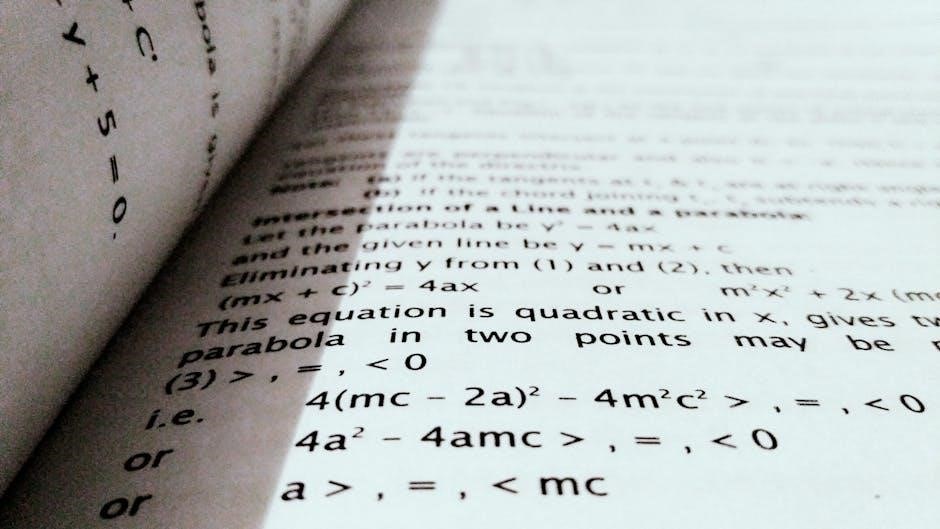Quadratic equations are second-degree polynomials of the form ax² + bx + c = 0․ Factoring is a primary method for solving these equations efficiently․ It involves breaking down complex expressions into simpler, multiplicative factors, enabling easy identification of roots․ This approach is both time-saving and fundamental for algebraic problem-solving․ Worksheets, especially in PDF format, provide structured practice, helping students master factoring techniques and improve their understanding of quadratic equations․
1․1 What Are Quadratic Equations?
Quadratic equations are polynomial equations of degree two, expressed in the standard form ax² + bx + c = 0, where a, b, and c are constants, and a ≠ 0․ These equations are fundamental in algebra and often arise in real-world applications, such as physics and engineering․ They graph as parabolas, and their solutions, or roots, can be found through methods like factoring, completing the square, or using the quadratic formula․ Factoring is a popular approach for solving these equations efficiently․
1․2 Importance of Factoring in Solving Quadratic Equations
Factoring is a cornerstone technique for solving quadratic equations, enabling students to break complex expressions into simpler, multiplicative components․ This method simplifies identifying roots and zeros, which are essential for graphing and analyzing parabolic functions․ By mastering factoring, students gain a deeper understanding of algebraic structures and develop problem-solving skills․ Worksheets, particularly in PDF format, provide structured practice, reinforcing these concepts and improving proficiency in solving quadratic equations through factoring․ Regular practice enhances accuracy and speed, making factoring an indispensable tool in algebraic problem-solving․

Benefits of Using Worksheets for Factoring Quadratic Equations
Worksheets provide structured practice, reinforcing factoring skills and identifying common mistakes․ They offer convenience in PDF format, allowing students to practice anywhere and master quadratic equation solving effectively․
2․1 Practice and Reinforcement
Worksheets provide structured practice, helping students build confidence in factoring quadratic equations․ They offer a variety of problems, from simple to complex, reinforcing key concepts․ Regular practice improves problem-solving skills and reduces errors․ Resources like Kuta Software and Maths Genie worksheets include example problems and exercises, ensuring thorough mastery․ These tools are especially useful for identifying and addressing learning gaps, making them invaluable for students seeking to excel in quadratic equation solving․
2․2 Identifying Common Mistakes
Worksheets help students recognize and correct common errors in factoring quadratic equations․ Frequent mistakes include incorrect factoring of trinomials, forgetting to factor out the GCF, and improper application of the zero product property․ Additionally, students often struggle with identifying factorable equations and may misapply factoring techniques to non-factorable expressions․ PDF resources, such as those from Kuta Software, highlight these errors through example problems, allowing students to learn from their mistakes and improve their factoring skills more effectively․
2․3 Convenience of PDF Format
PDF worksheets offer a convenient and organized way to practice factoring quadratic equations․ They are easily accessible, printable, and can be completed digitally․ Many resources, like those from Kuta Software and Maths Genie, provide structured exercises with answers, ensuring students can self-check their work․ The PDF format maintains consistent formatting, making it ideal for both classroom and independent study․ This accessibility helps students master factoring techniques efficiently, with resources available anytime and anywhere for continuous practice․

Step-by-Step Process of Solving Quadratic Equations by Factoring
Start by identifying factorable equations, then factor out the GCF․ Next, factor trinomials into binomials or apply the zero product property to find solutions․
3․1 Identifying Factorable Equations
Identifying factorable quadratic equations is the first step in solving them․ These equations are typically in the form ax² + bx + c = 0, where the trinomial can be factored into two binomials․ To determine if an equation is factorable, look for pairs of numbers that multiply to ac and add up to b․ This method works well for equations with integer coefficients and is a fundamental skill for algebraic problem-solving․ Regular practice with worksheets helps refine this technique․
3․2 Factoring Out the Greatest Common Factor (GCF)
Factoring out the GCF is a crucial step in simplifying quadratic expressions․ Begin by identifying the largest common factor among all terms in the equation․ For example, in 2x² + 4x + 6, the GCF is 2․ Factor this out to rewrite the expression as 2(x² + 2x + 3)․ This step reduces complexity, making further factoring easier․ Regular practice with worksheets helps students quickly identify and factor out the GCF, improving their efficiency in solving quadratic equations․
3․3 Factoring Trinomials
Factoring trinomials involves breaking them into two binomials․ Start with a quadratic trinomial in the form ax² + bx + c․ Multiply a and c, then find two numbers that multiply to ac and add to b․ These numbers help split the middle term, enabling factoring by grouping․ For example, in 2x² + 5x + 3, find numbers that multiply to 6 (2*3) and add to 5, which are 2 and 3․ Rewrite the equation as 2x² + 2x + 3x + 3, group into (2x² + 2x) + (3x + 3), factor out GCF from each group, and then factor out the common binomial to get (2x + 3)(x + 1)․ This method is effective for many trinomials, though not all factor neatly, requiring alternative methods like the quadratic formula when necessary․ Regular practice with worksheets helps master this skill, crucial for solving quadratic equations efficiently․
3;4 Applying the Zero Product Property
After factoring a quadratic equation into two binomials, the zero product property states that if the product of two factors is zero, at least one of the factors must be zero․ For example, if (mx + n)(px + q) = 0, then either mx + n = 0 or px + q = 0․ Solving each equation gives the solutions to the original quadratic equation․ This property simplifies finding roots by breaking down complex equations into manageable parts, making it a powerful tool in algebraic problem-solving․
3․5 Finding the Solutions
Once the equation is factored and set to zero, each factor is solved individually․ For example, if the factored form is (x + 3)(x ⎼ 2) = 0, set each factor equal to zero: x + 3 = 0 or x ⎼ 2 = 0․ Solving these gives x = -3 and x = 2․ These solutions are the roots of the equation and represent the x-intercepts of the parabola․ Always verify solutions by substituting them back into the original equation to ensure accuracy and completeness․

Common Types of Quadratic Equations for Factoring
Quadratic equations can be factored into perfect square trinomials, difference of squares, or standard trinomials․ Each type requires specific techniques to factor efficiently and find solutions․
4․1 Perfect Square Trinomials
Perfect square trinomials are quadratic expressions that can be written as the square of a binomial, such as ( (ax + b)^2 )․ They follow the pattern ( ax^2 + bx + c ), where ( a ) and ( c ) are perfect squares, and ( b ) is twice the product of their square roots․ For example, ( x^2 + 6x + 9 ) factors to ( (x + 3)^2 )․ Recognizing these patterns is crucial for efficient factoring and solving quadratic equations․ Worksheets often include examples of perfect square trinomials to practice this skill․
4․2 Difference of Squares
The difference of squares is a special factoring pattern for expressions of the form ( a^2 ⎼ b^2 ), which factors into ( (a + b)(a ⎼ b) )․ This method is particularly useful for simplifying expressions like ( x^2 ⎼ 16 ), which factors to ( (x + 4)(x ー 4) )․ It is important to note that this pattern applies only to subtraction, not addition, and requires recognizing the squares of terms․ Worksheets often include problems that focus on identifying and factoring differences of squares, helping students master this essential quadratic equation-solving technique․
4․3 Standard Trinomials
Standard trinomials are quadratic expressions of the form ax² + bx + c, where the coefficients a, b, and c are real numbers, and a ≠ 0․ These trinomials can often be factored into two binomials, (mx + n)(px + q), by finding two numbers that multiply to ac and add to b․ Worksheets commonly include exercises that focus on factoring standard trinomials, helping students develop the skills to break down complex expressions into simpler, solvable forms․ Regular practice with these problems enhances factoring accuracy and speed․

Example Problems and Solutions
This section provides example problems for factoring quadratic expressions and solving equations․ Worksheets include exercises like (x² + 5x + 6) and (2x² ⎼ 5x ⎼ 3), with detailed solutions․
5;1 Solving Simple Quadratic Equations
Solving simple quadratic equations by factoring involves breaking down the equation into two binomials․ Start by factoring out the greatest common factor (GCF), if possible, then factor the remaining trinomial․ For example, solve ( x^2 + 5x + 6 = 0 ) by factoring into ( (x + 2)(x + 3) = 0 ), yielding solutions ( x = -2 ) and ( x = -3 )․ Practice worksheets provide exercises like ( 2x^2 ⎼ 5x ー 3 = 0 ) to refine skills in identifying factors quickly and accurately․
5․2 Factoring More Complex Quadratic Expressions
Factoring more complex quadratic expressions requires advanced techniques․ Start by factoring out the GCF, then apply methods like difference of squares or perfect square trinomials․ For example, factor (x² ⎼ 16) as (x ー 4)(x + 4) or (x² + 4x + 4) as (x + 2)²․ For non-special trinomials, use factoring by grouping or the AC method․ Worksheets often include problems like (2x² ー 5x ⎼ 3) or (3x² + 4x ー 8), encouraging practice in breaking down intricate expressions systematically․

Tips for Students to Master Factoring Quadratic Equations
Master factoring by practicing consistently, starting with simple expressions․ Identify the GCF first and apply factoring techniques like difference of squares or perfect square trinomials․ Always verify solutions by substitution to ensure accuracy and understanding․ Break down complex problems into manageable steps and use online resources like PDF worksheets for additional practice and guidance․
6․1 Key Strategies for Successful Factoring
To excel in factoring quadratic equations, start by identifying the greatest common factor (GCF) and factor it out first․ This simplifies the expression, making it easier to handle․ Look for patterns like the difference of squares (a² ⎼ b²) or perfect square trinomials (a² + 2ab + b²)․ For standard trinomials, find two numbers that multiply to ac and add to b․ Use these numbers to break the middle term, then factor by grouping․ Regular practice with worksheets, especially in PDF format, reinforces these strategies and builds confidence․ Consistent application of these techniques ensures mastery of quadratic factoring․
6․2 Verifying Solutions Through Substitution
After factoring and solving quadratic equations, it is crucial to verify the solutions by substituting them back into the original equation․ This ensures the solutions satisfy the equation, confirming their accuracy․ For example, if x = 3 is a solution, replacing x with 3 in the equation should result in a true statement․ This step helps catch errors in factoring and reinforces understanding․ Worksheets often include space for this process, making it easier to track and confirm solutions effectively․

Advanced Techniques in Factoring Quadratic Equations
Advanced techniques include factoring by grouping, using special formulas, and applying quadratic equations’ properties․ These methods enhance problem-solving efficiency and are often practiced in PDF worksheets․
7․1 Special Factoring Techniques
Special factoring techniques include methods like factoring by grouping, which simplifies complex expressions into manageable factors․ Perfect square trinomials and difference of squares are also essential, as they follow specific patterns․ These advanced strategies allow students to solve a wider variety of quadratic equations efficiently․ Worksheets often include exercises that focus on these techniques, helping learners master them through practice․ They are particularly useful for tackling challenging problems that require a deeper understanding of factoring principles․
7․2 Using Technology to Aid Factoring
Technology, such as algebra software and online tools, can significantly aid in factoring quadratic equations․ Programs like Kuta Software and Math Genie offer interactive worksheets and step-by-step solutions, helping students understand complex factoring techniques․ Additionally, tools like ClassPad provide dynamic learning environments, combining written and digital practices․ These resources enhance problem-solving skills, reduce errors, and make learning more engaging․ They are especially useful for visual learners and those needing extra support, fostering a deeper understanding of quadratic factoring through interactive and accessible methods․

Common Mistakes to Avoid
Common mistakes include incorrect factoring of trinomials, forgetting to factor out the GCF, and misapplying the zero product property․ These errors can lead to incorrect solutions․
8․1 Incorrect Factoring of Trinomials
Incorrect factoring of trinomials often occurs due to improper grouping or splitting the middle term incorrectly․ Students may mistakenly pair numbers that do not multiply to the correct product or add incorrectly․ For example, in equations like x² + 5x + 6, incorrect factoring might result in (x + 2)(x + 3) instead of the correct factors․ Such errors stem from rushing or poor understanding of factoring techniques․ Always double-check by expanding the factors to ensure the original trinomial is restored․
8․2 Forgetting to Factor Out the GCF
One common mistake is neglecting to factor out the Greatest Common Factor (GCF) before factoring a quadratic trinomial․ For example, in 2x² + 4x + 6, the GCF is 2․ Failing to factor out the 2 first can lead to incorrect factoring․ Always identify and factor out the GCF to simplify the expression, making it easier to factor the remaining trinomial․ This step ensures accuracy and avoids unnecessary complications in solving quadratic equations․

Learning Difficulties and How to Overcome Them
Students often struggle with factoring quadratic equations due to difficulty in identifying common factors or correctly applying factoring formulas․ Regular practice with worksheets and breaking problems into smaller steps can help build confidence and improve understanding․ Seeking additional resources or tutoring when needed is also beneficial for mastering these concepts effectively․

9․1 Identifying and Addressing Learning Gaps
Students often face challenges in factoring quadratic equations due to difficulties in recognizing common factors or applying factoring formulas correctly․ To address these gaps, it is essential to provide structured practice through worksheets and encourage breaking down problems into manageable steps․ Additionally, utilizing visual aids and real-world applications can enhance understanding and retention․ Regular review of fundamental concepts and seeking supplementary resources when needed can also significantly improve mastery of factoring quadratic equations․
9․2 Recommended Resources for Additional Practice
For additional practice, resources like Kuta Software worksheets offer extensive problem sets on factoring quadratics․ Maths Genie provides exam-style PDF worksheets with detailed solutions․ EffortlessMath․com offers clear, printable materials․ These resources cater to different learning styles, ensuring comprehensive understanding․ They include structured exercises, examples, and answers, making them ideal for self-study or classroom use․ Utilizing these tools helps reinforce factoring skills and builds confidence in solving quadratic equations effectively․
Mastering quadratic equations through factoring is essential for algebraic proficiency․ Worksheets in PDF format provide invaluable practice, reinforcing skills and ensuring a strong foundation for advanced problem-solving․
10․1 Summary of Key Concepts
Factoring quadratic expressions is a fundamental algebraic skill, enabling the solution of quadratic equations efficiently․ Key steps include identifying factorable forms, factoring out the GCF, and applying the zero product property․ Worksheets in PDF format provide structured practice, helping students recognize patterns and avoid common mistakes․ Regular practice with such resources ensures mastery, reinforcing understanding and preparing students for more complex mathematical challenges in the future․
10․2 Encouragement for Continuous Practice
Consistent practice is essential for mastering quadratic factoring․ Daily engagement with worksheets, even for short periods, reinforces skills and builds confidence․ Utilize PDF resources like those from Kuta Software or Maths Genie for structured exercises․ Embrace challenges as opportunities to grow, and remember, persistence leads to proficiency․ Encourage peers and seek guidance when needed․ With dedication, you’ll excel in solving quadratic equations and develop a strong foundation for advanced math․



